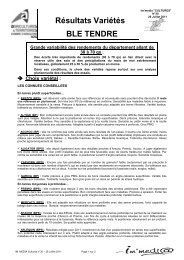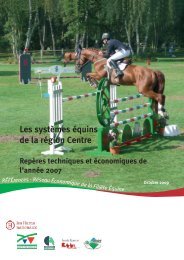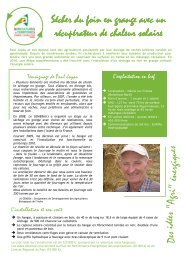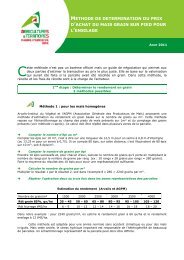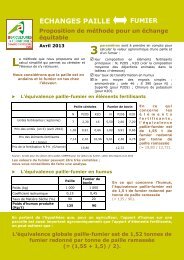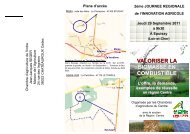Guide et références pour renseigner le Plan Prévisionnel de Fumure ...
Guide et références pour renseigner le Plan Prévisionnel de Fumure ...
Guide et références pour renseigner le Plan Prévisionnel de Fumure ...
You also want an ePaper? Increase the reach of your titles
YUMPU automatically turns print PDFs into web optimized ePapers that Google loves.
Mon plan prévisionnel <strong>de</strong> fertilisation N P K<br />
Version prairies<br />
Le principe du calcul <strong>de</strong> la dose d’azote, <strong>de</strong> phosphore <strong>et</strong> <strong>de</strong> potasse<br />
consiste à équilibrer <strong>le</strong>s besoins du peup<strong>le</strong>ment végétal avec <strong>de</strong>s apports,<br />
ceux du sol <strong>et</strong> <strong>de</strong>s engrais minéraux <strong>et</strong> organiques : c’est <strong>le</strong> principe du bilan<br />
.<br />
Ce plan prévisionnel <strong>de</strong> fumure doit être préparé en tout début <strong>de</strong><br />
campagne, <strong>pour</strong> adapter <strong>le</strong>s apports organiques <strong>et</strong> minéraux aux besoins <strong>de</strong><br />
la prairie.<br />
Il est aujourd’hui obligatoire dans <strong>le</strong> cadre <strong>de</strong> la Directive Nitrates, ou <strong>pour</strong> <strong>le</strong>s<br />
exploitants ayant souscrit une Mesure Agro Environnementa<strong>le</strong> <strong>de</strong>puis 2007<br />
(dont PHAE2) dans <strong>le</strong> cadre <strong>de</strong> la conditionnalité <strong>de</strong>s ai<strong>de</strong>s PAC. Il s’agit<br />
toutefois d’un véritab<strong>le</strong> outil <strong>de</strong> progrès agronomique qui perm<strong>et</strong> <strong>de</strong> gérer au<br />
mieux <strong>le</strong>s engrais <strong>de</strong> ferme, <strong>de</strong> faire <strong>de</strong>s économies en ajustant ses<br />
comman<strong>de</strong>s d'engrais, tout en respectant <strong>le</strong> potentiel <strong>de</strong> la parcel<strong>le</strong>.<br />
Bien évi<strong>de</strong>mment, il s’agit là d’un modè<strong>le</strong> basé sur <strong>de</strong>s <strong>références</strong> loca<strong>le</strong>s ou<br />
nationa<strong>le</strong>s. Pour qu’il soit <strong>le</strong> plus juste possib<strong>le</strong>, vous pouvez valoriser vos<br />
analyses (<strong>de</strong> sol, d’effluent organique, d’herbe…).<br />
C<strong>et</strong>te fiche propose <strong>de</strong>s normes <strong>et</strong> <strong>de</strong>s explications <strong>pour</strong> remplir ce plan<br />
prévisionnel <strong>de</strong> fumure. Suivez <strong>le</strong> gui<strong>de</strong> ci-<strong>de</strong>ssous <strong>pour</strong> <strong>le</strong> <strong>renseigner</strong>…<br />
- Je renseigne <strong>le</strong> n°îlot/parcel<strong>le</strong> <strong>et</strong> ses caractéristiques<br />
- 1) Je calcu<strong>le</strong> la dose <strong>de</strong> N à apporter p2<br />
- 1’) Je calcu<strong>le</strong> <strong>le</strong>s doses <strong>de</strong> P2O5 <strong>et</strong> K2O à apporter p3<br />
- 2) Je prends en compte l’apport <strong>de</strong> mes engrais <strong>de</strong> ferme p4<br />
- 3) Je détermine la quantité résiduel<strong>le</strong> à apporter avec <strong>de</strong>s engrais<br />
minéraux<br />
1
I) Je calcu<strong>le</strong> la dose d’azote à apporter<br />
(1) Objectif <strong>de</strong> production en tonnes <strong>de</strong> MS / ha (à ajuster selon <strong>le</strong> niveau<br />
d’intensivité)<br />
Mo<strong>de</strong> d’exploitation<br />
Chargement au<br />
printemps<br />
≤ 25<br />
ares /<br />
UGB<br />
≈ 35<br />
ares /<br />
UGB<br />
≥ 45<br />
ares /<br />
UGB<br />
Objectif <strong>de</strong> production<br />
Bon :<br />
sol sain, peu<br />
séchant, flore<br />
correcte<br />
Potentiel agronomique<br />
Moyen :<br />
un peu séchant<br />
l’été, flore<br />
correcte<br />
Faib<strong>le</strong> :<br />
hydromorphe<br />
l’hiver, séchant<br />
l’été<br />
Pâture toute l’année<br />
8 à<br />
10<br />
6 à 8 4 à 6 - - -<br />
Fauche précoce (avant<br />
<strong>le</strong> 1/06) + pâture<br />
- - - 8 à 10 5 à 7 4 à 6<br />
Fauche tardive (après <strong>le</strong><br />
1/06) + pâture<br />
- - - 7 à 9 5 à 7 4 à 6<br />
Fauche précoce avec<br />
regain + pâture<br />
- - - 9 à 11 6 à 8 (5 à 6)<br />
Fauche uniquement - - - 8 à 11 6 à 8 (5 à 6)<br />
(2) Azote exporté (en kg N / tonne <strong>de</strong> MS)<br />
Mo<strong>de</strong> d’exploitation<br />
Exportations d’azote (kg N / t MS)<br />
Pâture toute l’année 25<br />
Fauche précoce (avant <strong>le</strong> 1/06) + pâture 25<br />
Fauche tardive (après <strong>le</strong> 1/06) + pâture 20<br />
Fauche précoce avec regain + pâture 25<br />
Fauche uniquement 20<br />
(3) Fournitures du sol (en kg N/ha/an)<br />
Potentiel <strong>de</strong> production<br />
Fournitures du sol (kg N / ha / an)<br />
> 9 t MS / ha / an 110<br />
Entre 6 <strong>et</strong> 9 t MS / ha / an 80<br />
< 6 t MS / ha / an 50<br />
(4) Restitutions au pâturage (en kg N/ha/an)<br />
Mo<strong>de</strong> d’exploitation<br />
Restitutions au pâturage (kg N / ha / an)<br />
Pâture toute l’année 40<br />
Fauche précoce (avant <strong>le</strong> 1/06) + pâture 30<br />
Fauche tardive (après <strong>le</strong> 1/06) + pâture 20<br />
Fauche précoce avec regain + pâture 10<br />
Fauche uniquement 0<br />
(5) Contribution <strong>de</strong>s légumineuses (en kg N/ha/an)<br />
Potentiel agronomique<br />
Taux <strong>de</strong> légumineuses l’été Bon Moyen Faib<strong>le</strong><br />
Pas ou très peu : < 20 % 0 0 0<br />
Significatif : Entre 20 <strong>et</strong> 40% 45 40 20<br />
Important : > 40 % 90 70 50<br />
2
I’) Je détermine <strong>le</strong>s doses <strong>de</strong> P <strong>et</strong> K à apporter<br />
L’outil <strong>le</strong> plus pertinent <strong>pour</strong> déterminer <strong>le</strong>s doses <strong>de</strong> P <strong>et</strong> K à apporter est l’analyse d’herbe.<br />
En eff<strong>et</strong>, l’analyse <strong>de</strong> terre tel<strong>le</strong> qu’el<strong>le</strong> était pratiquée sur prairie s’est avérée peu pertinente<br />
<strong>pour</strong> évaluer la disponibilité <strong>de</strong> P <strong>et</strong> K dans <strong>le</strong> sol. Ceci a conduit l’INRA à proposer un<br />
diagnostic basé sur l’analyse d’herbe. L’analyse du végétal nous informe sur <strong>le</strong>s teneurs en<br />
azote, phosphore <strong>et</strong> potassium <strong>de</strong> l’herbe au moment du prélèvement. On obtient <strong>de</strong>s<br />
indices <strong>de</strong> nutrition P (iP) <strong>et</strong> K (iK) <strong>de</strong>s plantes, qui perm<strong>et</strong>tent <strong>de</strong> porter un jugement sur la<br />
pertinence <strong>de</strong> la fertilisation P K pratiquée <strong>et</strong> d’en proposer une éventuel<strong>le</strong> modification en<br />
relation avec <strong>le</strong>s objectifs <strong>de</strong> production.<br />
Renseignements auprès <strong>de</strong> votre technicien Chambre d’Agriculture ou auprès du service é<strong>le</strong>vage au 02.54.61.61.54 (coût : ≈<br />
25€ par analyse).<br />
Indices IP <strong>et</strong><br />
IK<br />
Niveau <strong>de</strong><br />
fertilisation<br />
PK<br />
Décision <strong>de</strong><br />
fertilisation<br />
PK<br />
o IP = 100 [(%P) / (0,15 + 0,065 (%N)]<br />
o IK = 100 [(%K) / (1,6) + 0,525 (%N)]<br />
40-60 60-80 80-100 100-120 120 <strong>et</strong> +<br />
Très insuffisant Insuffisant Satisfaisant Très satisfaisant Excé<strong>de</strong>ntaire<br />
Maintien ou augmentation<br />
Maintien ou<br />
réduction<br />
Impasse<br />
Si on ne dispose pas d’analyse d’herbe, on calcu<strong>le</strong>ra <strong>le</strong>s exportations tota<strong>le</strong>s <strong>de</strong> P2O5 <strong>et</strong> K2O<br />
à l’ai<strong>de</strong> du tab<strong>le</strong>au ci-<strong>de</strong>ssous. C<strong>et</strong>te va<strong>le</strong>ur calculée <strong>pour</strong>ra être considérée comme <strong>le</strong> seuil<br />
maximal à ne pas dépasser.<br />
Mo<strong>de</strong> d’exploitation<br />
Exportations <strong>de</strong> P2O5 Exportations <strong>de</strong> K2O<br />
(kg / t MS)<br />
(kg / t MS)<br />
Pâture toute l’année 7 35<br />
Fauche précoce (avant <strong>le</strong> 1/06) + pâture 6 25<br />
Fauche tardive (après <strong>le</strong> 1/06) + pâture 5 20<br />
Fauche précoce avec regain + pâture 6 25<br />
Fauche uniquement 5 20<br />
3
2) Je prends en compte l’apport <strong>de</strong> mes engrais <strong>de</strong> ferme<br />
(6) Va<strong>le</strong>ur fertilisante <strong>de</strong> l’effluent<br />
Utiliser une analyse récente <strong>et</strong> personnel<strong>le</strong> <strong>de</strong> fumier ou lisier. A défaut, voici <strong>de</strong>s va<strong>le</strong>urs<br />
moyennes issues d’expérimentations nationa<strong>le</strong>s :<br />
Composition moyenne <strong>de</strong>s<br />
déjections (en kg/t ou m 3 )<br />
Espèces<br />
Nature <strong>de</strong>s déjections Production annuel<strong>le</strong> N P2O5 K2O<br />
anima<strong>le</strong>s<br />
Fumier 15 t / animal 5,5 2,6 7,2<br />
Bovins<br />
Lisier 18 m 3 / animal 4 2 5<br />
Veaux Lisier 2,2 m 3 / animal 2,86 1,36 2,7<br />
0,7 m<br />
Lisier<br />
3 / porc charcutier<br />
5 4 3<br />
présent<br />
Porc<br />
1 t / porc charcutier<br />
Fumier<br />
4,1 3,2 3,4<br />
présent<br />
Lisier 0,073 m 3 / place anima<strong>le</strong> 6,8 9,5 5,5<br />
Pou<strong>le</strong>s<br />
Fientes sèches 0,020 t / place anima<strong>le</strong> 20 35 20<br />
pon<strong>de</strong>uses<br />
Fumier volail<strong>le</strong>s <strong>de</strong> chair 0,150 t / m² d’animaux 29 29 20<br />
Canards Fumier 0,374 t / m² d’animaux 5 8 4<br />
Lapins Lisier 0,5 m 3 / animal 9 13,4 7,4<br />
Lisier 1,3 m 3 / animal 7,7 4,6 12,31<br />
Ovins<br />
Fumier 1 t / animal 10,8 6,3 17,6<br />
Exemp<strong>le</strong> : 20 tonnes par hectare <strong>de</strong> fumier <strong>de</strong> bovins épandus sur une prairie permanente :<br />
N total = 205,5 = 110 kg N / ha<br />
P2O5 total = 202,6 = 52 kg P2O5 / ha<br />
K2O total = 207,2 = 144 kg K2O / ha<br />
Remarque : je respecte donc mon engagement PHAE2 ou MATER Brenne qui limite <strong>le</strong>s apports totaux à<br />
125uN/ha/an, 90uP2O5/ha/an, <strong>et</strong> 160uK2O/ha/an.<br />
(8) Coefficient d’équiva<strong>le</strong>nce engrais<br />
Pour l’azote<br />
Pério<strong>de</strong> d’apport<br />
Effluent Automne - hiver Printemps<br />
Compost bovins 0,2* 0,05<br />
Fumier bovins, caprins, ovins 0,25* 0,1<br />
Fumier porcs 0,4 0,4<br />
Lisier bovins - 0,5<br />
Lisier porcs 0,4* 0,65*<br />
Fumier volail<strong>le</strong>s 0,4* -<br />
Fientes volail<strong>le</strong>s -<br />
Normes CORPEN<br />
Institut <strong>de</strong> l’E<strong>le</strong>vage <strong>et</strong> *Ferme <strong>de</strong>s Bor<strong>de</strong>s<br />
Pour <strong>le</strong> phosphore <strong>et</strong> la potasse<br />
Engrais <strong>de</strong> ferme Coefficient P2O5 Coefficient<br />
K2O<br />
Fumiers <strong>de</strong> bovins, <strong>de</strong> caprins, <strong>de</strong> chevaux <strong>et</strong> <strong>de</strong> porcs, lisiers<br />
<strong>de</strong> bovins, purins<br />
1 1<br />
Lisiers <strong>de</strong> porcs ainsi que composts issus <strong>de</strong> ces lisiers 0,85 1<br />
Lisiers <strong>de</strong> volail<strong>le</strong>s, lisiers <strong>de</strong> lapins, fientes <strong>de</strong> volail<strong>le</strong>s ou fumiers<br />
<strong>de</strong> volail<strong>le</strong>s ainsi que composts issus <strong>de</strong> ces produits<br />
0,65 1<br />
« Fertiliser avec <strong>le</strong>s engrais <strong>de</strong> ferme », IE-ITAVI-ITCF-ITP, 2001<br />
Exemp<strong>le</strong> : 20 tonnes par hectare <strong>de</strong> fumier <strong>de</strong> bovins épandus sur une prairie permanente<br />
N efficace = 1100,25 = 27,5 kg N / ha<br />
P2O5 efficace = 521 = 52 kg P2O5 / ha<br />
K2O efficace = 1441 = 144 kg K2O / ha<br />
Remarque : ce n’est pas la fertilisation efficace mais bien la fertilisation tota<strong>le</strong> (Cf. exemp<strong>le</strong> plus haut) qui est prise<br />
en compte dans <strong>le</strong>s plafonds imposés par <strong>le</strong>s MAE (PHAE2, MATER Brenne). Ces coefficients sont <strong>de</strong>s normes<br />
agronomiques, qui perm<strong>et</strong>tent <strong>de</strong> connaître la quantité utilisab<strong>le</strong> <strong>pour</strong> <strong>le</strong>s plantes l’année d’épandage (calcul<br />
plus précis).<br />
4



